Pete's World
Tuesday, February 28, 2006
Thursday, February 16, 2006
Activity #4
The Vintagers

This is an afternoon scene of a group of vintagers, a producer or harvester of wine grapes, arriving home while the sun begins to set off to the right where it can not be scene. The unity in this piece is of distinct color throughout the fields. The deep green and slight blue shading to the light green almost golden color that flows all around the village gives it unity with variety of color. The focal points are the villagers in the foreground on the path home. Their distinct color and shapes give them emphasis in contrast to the surrounding fields. They seem to be carrying something on their backs, which may be the grapes they have picked, giving them a rounded distinct shape with protruding legs. A lady has on a white hat that is set apart from the tan road and dark field. The houses and the church are subordinate objects in the background. Because the villagers are in the foreground they seem to be disproportional compared to the houses in the foreground, almost not to scale. Finally the colors of the fields along with the shading gives this piece a rhythm that flows around the painting from the foreground to the back.
Voyage of Life:Manhood

Unified by a dark gloomy red, this scene has a few objects that make it apparent from the rest on the piece. The man on the boat with his bright red clothes draws ones eyes to him and then down the dark blue river into the smoothly glowing sunset. From the sunset we can see more things that stand out. The grey cloud that could be demons in the sky agreeing with this gloomy scene. Then the angel in the top left corner is a very distinct character with the bright glowing white. These images add emphasis to this piece and are the focal points with the rocky mountains in the background being the subordinate images. These images give the piece a sort of variety that mixes up the unified dark color. The horizon causes a asymmetrical balance in this piece. The painting is divided into two parts by a horizontal line going through the middle. It splits up a scene of dark, depressive, dangerous jutting rocks and ragging river; and a scene of the setting sun as glowing and peaceful. A rhythm flows with the man on the ragging river through the rocks to the peaceful ocean where the warm colors of the setting sun are.
Creative Post
Creative Post #11
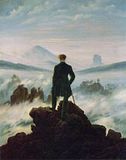
Wanderer Above the Sea of Fog (Mountaineer in a Misty Landscape)1818
Caspar David Friedrich
oil oncanvas
This piece was very interesting. It shows a man ontop of what seems to be a mountain, looking over a cloudy, foggy, scene. But why? Why is he up there? What is he doing? You can put yourself in this mans place, because we have all been there, starring off into space, daydreaming, thinking out loud. This person has just found a wonderful spot to do it in. I lved the deep colors of this piece, the atmosphereic perspective of the mountains in the distance. The waving, wipping clouds add a sense of uncertainty in the air. It is an amazing piece that I enjoy studying over and over again.
Creative Post #10
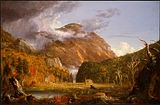
Thomas Cole
A View of the Mountain Pass Called the Notch of the White Mountains (Crawford Notch), 1839
oil on canvas
This painting by Cole was one I was thinking of choosing for my Museum paper. It is an amazing scene, that can really captivates by looking at it and even more if you put yourself into the painting; viewing this scene like the person on the horse a feeling of shock and awe comes over you. I love the color scheme in this painting, so many different colors make up the woods and fields and maountain. There is almost a sense of asymmetry between the roaring storm and the calm wooded valley below.
Creative Post #9

I found this picture on a Astronomy Picture website http://antwrp.gsfc.nasa.gov/apod/archivepix.html. In Iceland in 1991, the volcano Hekla erupted at the same time that auroras were visible overhead. I thought this was a great depiction of asymmetry because of the violent eruption of the red hot volcano, versus the glowing green flow of the aurora.
Creative Post # 8
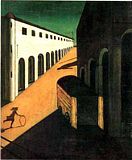
Melancholy and Mystery of a Street, GIORGIO DE CHIRICO, c. 1914. Is a piece I found very interesting. This piece was done during an art movement called Surrealism. The angles of the streets and the walls adds point of view and direction. The way the pale yellow road starts from one corner and flows to the other side growing narrow as it goes on carries your eyes through the painting. The way the white building is shaped adds to this effect as well.
Creative Post #7

I thought this was a very interesting picture. I came across it while I was looking at an astronomy website full of pictures. It was taken from the Internation Space Station. The object floating in the middle of the picture is a spacesuit that wasn't needed anymore, so the crew pushed it off the station. I just loved how the picture looks fake but isn't, and the contrast between the clear blue earth and the empty black space. It shows asymmetry.
Creative post #6
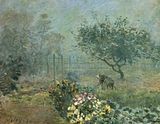
Alfred Sisley
Misty Morning
Oil on Canvas
This is another great Impressionist piece that really struck me when I first saw it. The analogous harmonies of the greens and blues that surround this piece are awesome. But the painting is set off my the contrasting colors of the white and pink flowers and yellow flowers that draws your attention away from the rest of the painting.
Creative Post #5
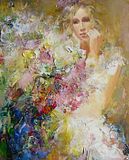
"Flowers Frome Him"
Oil on Canvas
I have discovered that I love Impressionist paintings. I think they are my favorite!!! And this piece really stood out too me. I love how the only detail is in the woman's face and hand, the main focal point of the painting. The blue vase also stands out from the rest of the piece, the colors blend together in the vase to make a beautiful bouquet of flowers.
Creative Post #4
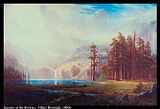
Albert Bierstadt uses atmoshperic perspective in this piece called Garden of the Rockies. I also enjoy the way the deep blue lake and dark red almost burgandy trees set themselves apart from the rest of the painting.
Creative Post #3
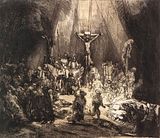
This is a print by Rembrandt. The medium is drypoint and burin printed on vellum. Drypoint uses a drypoint needle that scrathes a thin ridge of metal onto the surface of whatever is being created. These ridges hold the ink. These was a very impressive piece to me and I just had to put it on.
Creative Post #2
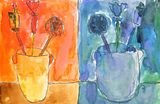

These are two great descriptions of asymmetrical paintings. Both pieces are split into two haves. And the even more interesing point is that the are seperated by their color scheme. One side are warm colors and the other side are cool colors.
Activity #3
What are the two main balances the text describes? Give an example of each.
The two balances the text describes are symmetrical and asymmetrical balance. Symmetrical balance is a descriptive design in which the two havles of a composition on either side of an imaginary central vertical axis correspond to one another in size, shape, and placement. Asymmetrical balance is characterized by arranging related or unrelated objects of differing visual weights counterbalancing one another. This can heighten interest, bring informality, or even produce tension in a painting.
An example of symmetrical balance is Georgia O'Keefe's
Deer's Skull with Pedernal
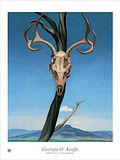
An example of asymmetrical balance is Joseph Mallory Turner The Burning of the Houses of Parliament

Wednesday, February 15, 2006
Activity # 2
Pierre-Auguste Renoir
The Vintages
1879
Oil on Canvas

The Vintagers by Pierre-Auguste Renoir
The painting I have chosen is The Vintagers by Pierre-Auguste Renoir. This painting has become a favorite of mine and I only noticed it a few days ago. I have always loved impressionist paintings and this one is a great. Impressionist painting seeks to re-create the artist's or viewer’s general impression of a scene. It is characterized by indistinct outlines and by small brushstrokes of different colors, which the eye blends at a distance. Soft, pastel colors appear frequently in impressionist paintings. I love looking at impressionist paintings up close and not being able to really decipher what I am looking at. It is only when you step back and look from a far do you see and entire scene unfold right in front of your eyes. I had no idea what a vintager was so I looked it up. A vintager is a producer or a harvester of wine grapes. The focal point of this piece is close to the bottom in the middle where the dark shading of the field. The deep green draws you in and directs you to the path the vintagers are on possibly on their way back from harvesting grapes. As ones eyes follow the vintagers and the path it leads into the town. Analogous harmonies are all over this piece. The yellow-green scheme of the fields is apparent of this. There are patches of brown within the field where possibly the pigments of yellow and green and brown were mixed making a deeper brown through a subtractive process. The pale almost pink hue of the roofs of the homes in this piece stand out against the fields very well. Near the top right corner hidden among the lightly colored brown trees is a large protruding structure, which may be a church. It is well shaded and almost is overlooked if not studied carefully.
Thomas Cole
The Voyage of Life: Manhood
1842
Oil on Canvas

The Voyage of Life: Manhood
Thomas Cole
I chose Thomas Cole’s The Voyage of Life: Manhood because it looked very interesting to me as I looked at it more and more. As I examined the piece I discovered so many elements that made me love it. It is a dark piece that can almost be expressed as monochromatic with it’s over all dark red appearance to it. With exceptions of the angel, river, boat, a grey almost blue cloud, and the man’s clothes the hue is a very deep dark red. This red can be seen as symbolizing the evils or temptations of the world. This piece is overwhelmed with movement and line. There is a lot of use of diagonal: the upward jutting rocks, a downward sweeping river. Directional line moves from the man on the boat through these dangerous waters and into the narrow rock face. This symbolizes some of the trials and tribulations of middle age. After our eyes flow through the rock face we can see that the river runs into an ocean with a setting sun on the horizon. Here is the actual focal point of the painting. The horizon is the only horizontal line in the painting. This setting sun is a warm color which immediately grabs our attention away from the hectic scene around it. This ocean symbolizes the end of life. There is also a hint of atmospheric perspective with the mountains in the distance looking as if the were shadows they are so dim. There is a constant use of shading on the mountains as a result of the light from the angel as well as the approaching sun.
